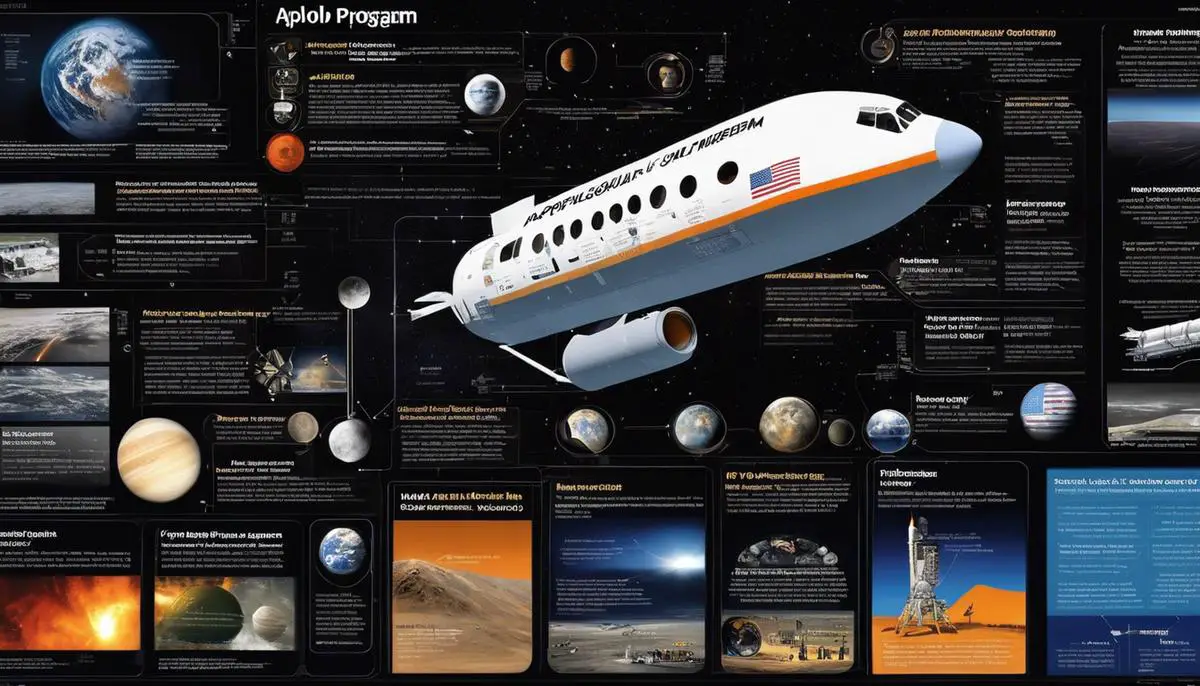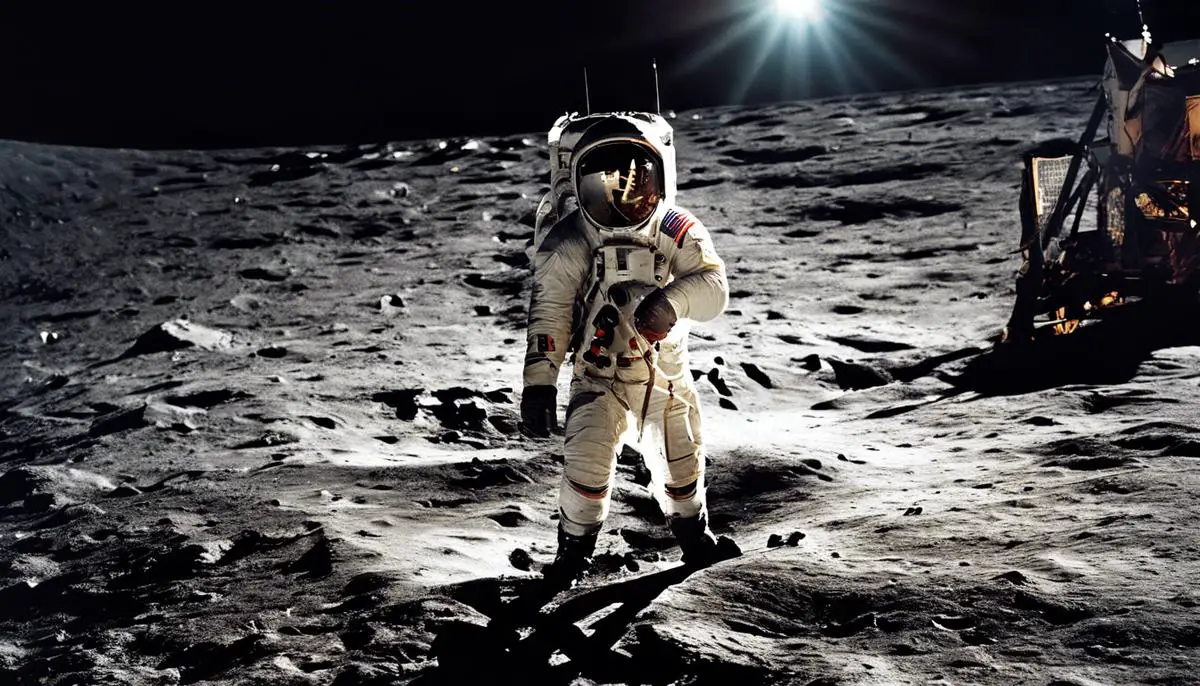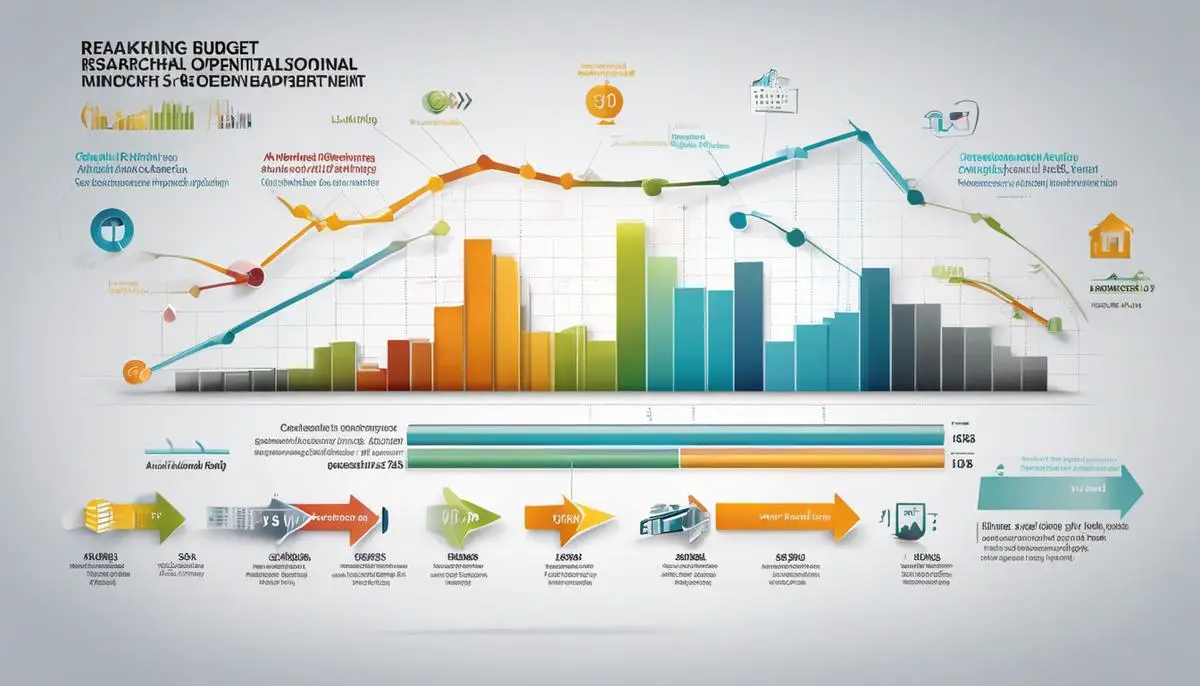On July 20th, 1969, humanity etched a landmark achievement into the annals of history with the Apollo 11 moon landing. This singular event, transcending mere exploration, became a symbol of what human determination, ingenuity, and collective effort can accomplish. At the heart of this monumental venture was a fiscal narrative that is as captivating as the technical marvels it fostered. Delving into the budget allocation and management of NASA’s Apollo 11 mission unveils a tapestry woven with precise financial planning and strategic deployment of resources. Equally critical was the careful balance struck between the high stakes of spaceflight innovation and the meticulous stewardship of public funds—a balance pivotal to the success of this unprecedented odyssey.
Contents
Budget Allocation and Management
Fiscal Stewardship of Apollo 11: Budget Allocation and Management
Abstract
The Apollo 11 mission, one that ensconced humanity’s first lunar footsteps into the annals of history, was an endeavor fuelled by considerable financial investment. This article elucidates the intricate budget allocation and management that facilitated this monumental achievement, detailing the economic underpinnings that supported one of the most significant milestones in space exploration.
Budget Overview
The Apollo program’s overarching quest to land a man on the Moon and return him safely to Earth was underpinned by a budget that was, unsurprisingly, astronomical. The Apollo 11 mission itself emerged as a focal point within this cadre, necessitating meticulous financial planning and allocation. It is incumbent upon one to understand the fiscal scope of the Apollo 11 mission to appreciate the meticulous budget management that transpired.
Allocation Strategy
Given the importance of the mission, NASA allocated the Apollo 11 budget across several critical domains. The largest expenditure was on the Saturn V launch vehicle, a towering marvel of engineering that required an extensive outlay for materials, construction, and testing. The Command and Service Module (CSM), along with the Lunar Module (LM), represented significant budgetary allocations as well, owing to their complexity and the paramountcy of ensuring their reliability.
A considerable portion of the budget was also directed toward research and development, epitomizing the mission’s pioneering nature. Unprecedented challenges in guidance, navigation, and life support systems demanded significant allocation of funds, driving innovative solutions that were hitherto inconceivable.
Infrastructure and facilities also commanded a noteworthy fraction of the budget. The construction of launch complex 39, the Vehicle Assembly Building, and the groundwork at the Kennedy Space Center were deemed essential expenditures, laying down the physical groundwork necessary for the mission to proceed.
Workforce Excellence
It is worth noting the investment in human capital—the engineers, technicians, scientists, and astronauts whose expertise was indispensable. Training, simulation, and support personnel were financed in a bid to ensure that every possible scenario was accounted for, and that the crew would be prepared for tasks as routine as equipment checks and as daunting as extravehicular activities on the lunar surface.
Operational Costs
Ongoing costs, such as mission control operations, telecommunications, tracking, and recovery operations, were meticulously accounted for within the budget. Each of these components was crucial to the mission’s success, demanding faultless execution and hence, equivalently attentive financial provision.
Program Management
Critical to Apollo 11’s fiscal responsibility was the stringent program management that NASA implemented. Regular audits, cost tracking, and budgetary reviews were ingrained in the management practices. Project managers were held accountable to the budgets, with an unwavering commitment to cost-effectiveness without compromising on the mission’s sanctity.
Conclusion
The Apollo 11 mission’s budget allocation encapsulates a story of not merely financial figures but of the valuation of intellect, foresight, and precision in planning. It showcases a financial doctrine that married the aspirations of a nation to the pragmatic realism of technological limitation. The triumph of Apollo 11 is as much a celebration of fiscal acumen as it is of scientific and technological ingenuity. It aptly demonstrates the critical role of efficient budget allocation in propelling humanity to achieve the erstwhile unreachable – to leave a mark on the Moon.

Technological Investments and Costs
Title: The Indispensable Financial Undertakings in Apollo 11’s Historic Voyage
The monumental journey of Apollo 11, which culminated in mankind’s first lunar footsteps, undeniably required an array of technological investments. Beyond the fiscal prudence exemplified through budget allocations and program management, pivotal financial commitments were channeled into technological domains critical to the mission’s triumph.
Satellite Communication Systems:
The Apollo 11 mission saw substantial investments in satellite communications infrastructure. This technology was imperative to facilitate real-time data relay and communication between the Earth-based mission control and the astronauts. The cost burdens here were twofold: designing cutting-edge satellite systems and ensuring an expansive network with fail-safes for continuous coverage.
The intricate guidance systems of the Apollo 11 craft, inclusive of the Inertial Measurement Unit and the Apollo Guidance Computer, deservedly garnered significant investment. The costs were not merely limited to the creation and testing of these devices but extended into myriad iterations for excellence and redundancy, which were crucial for the precise lunar landing.
Environmental Control Systems:
Human survivability in the unforgiving vacuum of space necessitated sophisticated environmental control systems. The life support investments entailed complex air revitalization, thermal control, and waste management subsystems. These systems demanded exhaustive validation trials, leading to non-trivial financial implications.
Space Suit Technology:
Developing the A7L space suit that would shield the astronauts on the lunar surface bore substantial costs. The technology’s specificity required expenditure on materials that offered protection against extreme temperature fluctuations, micro-meteoroids, and the vacuum of space, along with ensuring mobility to perform extravehicular activities.
Mission Simulation and Training:
Expenditures in this important preparatory phase were critical for mission assurance. Sophisticated simulation facilities were created, complete with computer-generated environments and physical mock-ups. Costs attributed to these simulations underscored their critical role in mission planning and astronaut readiness.
Insurance Costs:
A lesser-acknowledged but necessary financial consideration was the life insurance policies for the astronauts. The high-risk nature of the mission drove the costs for such insurances, which were provided by private insurers, and were perceptively greater compared to standard policies.
Post-Mission Analysis and Data Management:
Finally, investments in post-mission analysis ensured that the wealth of data collected during Apollo 11 led to a continuum of knowledge. This involved costs pertaining to data processing equipment, storage facilities, and teams dedicated to the systematic study of findings with implications spilling into general scientific advancement.
In visualizing the totality of Apollo 11’s arc, the encompassing investments beyond the immediacy of infrastructure and hardware become clear. Each dollar spent was directed toward sculpting a robust technological framework, enabling humanity to transcend earthly bounds and echo its ingenuity across the void of space. The fiscal commitments made were indeed as pivotal as the collective human spirit that spurred Apollo 11 onwards, marking an indelible chapter in the annals of exploration and technological achievement.

Economic Impact of the Apollo Program
The Apollo program, transcending its immediate spectacle of lunar exploration, engendered a plethora of profound economic impacts upon the United States, each undergirding and propelling innovative enterprises and boosting national economic vitality.
Central to the economic cascade was the innovation in satellite communication systems, which have since become the bedrock of modern global telecommunications. The exigencies of space communication necessitated advancements in satellite technology, which spilled over into commercial applications—providing expansive infrastructure for broadcast and data services, and inaugurating an era of global connectivity that has been a driving force in the modern information economy.
Progress in guidance and navigation systems, firstly devised for the meticulous task of directing spacecraft through the cislunar expanse, later suffused into navigational aids that are now commonplace. This technology underpinned the development of the Global Positioning System (GPS), an invaluable tool leveraged by sectors ranging from transportation to agriculture, emboldening efficiency and precision across myriad industries.
Furthermore, the environmental control systems developed for Apollo have incubated innovations in atmospheric purification and environmental regulation. These systems have transcended their original applications, proving instrumental across various industries where controlled environments are essential, such as pharmaceuticals, biotechnology, and advanced manufacturing.
Space suit technology, crafted to shield astronauts from the ruthless vacuum and temperature extremes of space, evolved into protective gear technologies that safeguard workers in hazardous environments on Earth. Developments in material science, life support systems, and ergonomic design seeded advancements in safety equipment used within various industrial and medical settings.
In the realm of mission simulation and training, Apollo’s exigencies led to the creation of sophisticated simulation technologies which have rippled through both academic pursuits and commercial endeavors. Simulators and related training methodologies have found applications in realms as diverse as aviation, medicine, and complex systems management. This technology endures as a cornerstone for preparing professionals to execute tasks where the margin for error is negligible.
Insurance costs associated with the Apollo missions initiated a whole sector—space insurance—which continues to evolve as commercial spaceflight becomes increasingly prevalent. The implications of risk assessment, management, and mitigation derived from insuring such pioneering endeavors have been instructive for industries confronting novel and high-risk enterprises.
Lastly, the post-mission analysis and data management associated with Apollo have broadened understanding in data processing and analytics. The meticulous work of dissecting mission data inaugurated new frontiers in informatics and computational techniques which have permeated sectors such as finance, healthcare, and cybersecurity, proving pivotal in managing and deciphering vast quantities of information.
In sum, the economic footprint of the Apollo program is far-reaching and indelibly interwoven into the fabric of contemporary industry and infrastructure. The initiative’s offshoots have left an enduring legacy, creating new sectors and transforming existing ones. The program stands as a paragon of how governmental investment in exploration and innovation can serve as a potent stimulus for widespread economic growth and prosperity. The clarity delineating the Apollo economic impact substantiates the inherent value of investing in ventures that, though they reach for the stars, ultimately ground their returns firmly on Earth.

Return on Investment for Humanity
The Apollo 11 mission, famously culminating in Commander Neil Armstrong’s historic step onto the lunar surface on July 20, 1969, is frequently lauded as one of humanity’s greatest technological achievements. However, the scientific and cultural payoff extends significantly beyond the mission’s immediate triumph. Herein we shall explore the broader implications of said mission, both in terms of scientific advancements and cultural enrichment.
Post-mission, Apollo 11 and subsequent missions provided an abundance of lunar samples. These samples have been instrumental in shaping our understanding of lunar geology, the formation of the Moon, and by extension, insights into the early history of the Earth. The lunar rocks returned by the Apollo missions remain a cornerstone for planetary geology, and their analysis has led to a cascade of peer-reviewed publications that continue to contribute to scientific knowledge. The synthesis of these data has refined the theory of the giant impact hypothesis, which posits that a Mars-sized body collided with the early Earth, resulting in the debris that would eventually coalesce into the Moon.
Culturally, Apollo 11 sparked an unprecedented interest in space and science. It was a watershed moment for humanity, symbolizing not only American leadership in space exploration but also the collective potential of human ambition and innovation. The mission acted as a catalyst for a new era of science education as the space race had highlighted the need for an enhanced focus on science and technology in schools, which in turn, led to the emergence of new generations of engineers and scientists inspired by the Apollo program’s grandeur.
Apollo 11 also served as a powerful unifier, fostering a sense of global camaraderie that transcended geopolitical disputes. As the images of Earthrise over the lunar horizon beamed back to Earth, they underscored our shared vulnerabilities and, paradoxically, our interconnected strength. These photographs, arguably, were instrumental in the burgeoning of the environmental movement, fostering a newfound appreciation for the planet’s fragility.
Commercially, the technologies developed for the Apollo program have permeated various industries. The miniaturization of electronics, the advancement of computer technologies, and the enhancement of materials science have given rise to consumer and industrial products that find lineage in NASA’s innovations. It is no understatement to claim that the microchip revolution, which has transformed the way we live and interact, owes a considerable debt to the demands and challenges posed by space travel.
In retrospect, the Apollo 11 mission provided a return on investment that transcended monetary evaluation. It carved a new trajectory for civilization – one which valued exploration, resilience, and a relentless pursuit of knowledge. The collective scientific and cultural capital accrued through Apollo 11 has indeed borne fruit in myriad and often intangible ways, enhancing the fabric of society and underpinning the edifice of contemporary scientific pursuits. It is this multifaceted legacy of Apollo 11 that continues to inspire and guide our voyage into the cosmos, as we stand on the shoulders of this monumental achievement in our enduring quest for discovery.

With the echoes of Neil Armstrong’s historic declaration still reverberating through time, the Apollo 11 mission’s legacy extends far beyond its financial ledger. Sifting through the meticulous accounting and technological expenditure reveals an enduring testament to the mission’s value. Apollo 11 was not merely an expedition that led mankind to the moon’s surface; it was an investment that catapulted humanity into a new era of technological possibility and global inspiration. The ripples of its accomplishments continue to expand the frontiers of our cosmic curiosity while enhancing life on Earth in myriad ways, melding the dreams of yesterday with the tangible realities of today and the boundless potentials of tomorrow.
